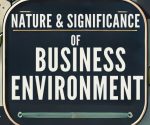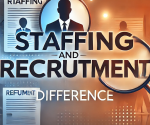Staffing is the process of identifying, recruiting, training, and retaining employees to meet an organization’s needs. Several strategies and services are included to meet an organization’s objectives and workforce dynamics. This article delves deep into six of the most prominent types of staffing, their unique features, benefits, and practical applications. Staffing is a vital function in human resource management that encompasses various methods and strategies to ensure an organization has the right talent in place. There are several types of staffing approaches, each tailored to meet different organizational needs and circumstances.
Types of Staffing
From addressing short-term seasonal demands to securing long-term roles or bridging gaps through temporary solutions, the right staffing approach ensures agility and operational excellence. The different types of staffing are as follows.
Temp-to-Hire Staffing
Temp-to-hire staffing is a hybrid form of employment that combines temporary and permanent employment systems. Organizations hire an employee temporarily and evaluate his or her performance and fit before offering a full-time position.
Features: Gain insight into the defining traits of temp-to-hire staffing that make it a flexible and trial-based solution.
- Conversion: Employers assess performance, cultural alignment, and adaptability. If the trial period proves successful, the temporary employee is converted into a permanent member of the team, ensuring both parties are satisfied.
- Flexibility for Both Parties: This staffing type offers a non-committal period, allowing the employer to gauge suitability without immediate long-term obligations and giving employees time to adapt to the new role.
Benefits : Understand how this staffing approach minimizes hiring risks and adapts to changing workforce needs.
- Reduced Hiring Risks: By observing an employee’s performance over the trial period, employers can minimize the chances of hiring the wrong candidate. This ensures better long-term compatibility.
- Probationary Period: Temp-to-hire staffing allows employers to manage fluctuating workloads effectively. If the workload decreases, the employer can avoid unnecessary long-term commitments.
Example: An IT firm hires a software developer on a three-month temp-to-hire contract to manage a project and then offers the candidate a permanent position if he performs well.
Direct Hire Staffing
Direct Hire Staffing is recruiting employees directly into an organization for long-term or permanent positions. The process seeks candidates who would fit in with the culture and mission of the organization.
Features: Explore the key attributes of direct hire staffing that focus on long-term and specialized roles.
- Suitability: Direct hire staffing is often utilized for high-level or specialized positions where the right candidate is crucial to the organization’s success. These roles often demand specific expertise or qualifications.
- Agencies: Recruitment agencies often assist in sourcing, vetting, and presenting qualified candidates. Their expertise in niche markets ensures that only the most suitable candidates are selected for the role.
Benefits: Discover the lasting advantages of securing highly skilled talent for organizational growth.
- Time: By leveraging the services of recruitment agencies, organizations can save valuable time and resources that would otherwise be spent on extensive search and evaluation processes.
- Team Integration: Long-term hires are more invested in the company’s culture and objectives. Direct-hire staffing helps create stable teams, promoting cohesion and collaboration within the organization.
Example: A pharmaceutical company directly hiring a senior research scientist for a newly introduced R&D division.
Payroll Services Hiring
Payroll Services Hiring is a process where businesses outsource payroll management while still having control over the performance and management of employees. It makes the administrative process of staffing much easier.
Features: Learn about the essential aspects of payroll services hiring that simplify workforce management.
- Third-Party Payroll Management: A professional payroll service provider handles all aspects of payroll management, including salary calculations, tax deductions, and benefit disbursements.
- Operational Role: Employers concentrate on their core operational roles and responsibilities without being burdened by payroll complexities. The payroll provider ensures that payments are timely and accurate.
Benefits: See how this approach enhances compliance, saves resources, and sharpens business focus.
- Ensures Compliance: Payroll service providers stay updated with ever-changing tax regulations and labor laws. This guarantees that businesses meet all legal requirements and avoid potential penalties.
- Time and Resources: Processing payroll in-house can be time-consuming and costly. Payroll services hiring saves businesses significant time and financial resources, allowing HR and finance teams to focus on strategic initiatives.
Example: A start-up outsourcing payroll services for 50 employees to reduce the administrative burden and free time to scale operations.
Strategic Staffing
Strategic Staffing integrates workforce planning with business strategy; it aligns staffing activities with long-term organizational goals. This includes forecasting future needs and developing a talent pipeline.
Features: Delve into the attributes of strategic staffing that align workforce planning with business objectives.
- Alignment: Strategic staffing ensures that hiring and workforce planning are closely tied to an organization’s long-term objectives. This alignment guarantees that the workforce supports the company’s mission and growth plans.
- Skill Development: Beyond filling roles, strategic staffing emphasizes training employees and preparing future leaders. Organizations invest in skill-building programs to ensure that employees grow alongside the company.
Benefits: Learn how this approach prepares organizations for market shifts and enhances competitiveness.
- Preparedness: Organizations adopting strategic staffing can anticipate industry trends and market shifts. By proactively preparing their workforce, they avoid skill gaps and ensure business continuity.
- Resilient Workforce: A strategically staffed organization has employees ready to adapt to new roles, challenges, or technologies, fostering agility in an ever-changing business environment.
Example: A manufacturing company identifying future leadership needs and enrolling high-potential employees in leadership training programs as part of strategic staffing.
Short-Term Staffing
Short-term staffing refers to the process of addressing immediate and temporary workforce needs, usually for a few weeks to months. It is suitable for seasonal businesses or project-specific requirements.
Features: Examine the core features of short-term staffing tailored for immediate and flexible workforce needs.
- Temporary Employment: Short-term staffing involves hiring employees for a specific project, season, or task.
- Flexibility: Employers can determine the duration of employment based on the workload and project timeline. This flexibility ensures that businesses can scale their workforce up or down as needed.
Benefits: Explore how this staffing type helps manage demand spikes efficiently and cost-effectively.
- Immediate Workforce Solution: Short-term staffing quickly fills vacancies or provides additional manpower for sudden increases in workload without long-term employment obligations.
- Cost-Effectiveness: Hiring short-term employees eliminates the expenses associated with full-time benefits, training, and long-term payroll commitments, making it an economical choice for temporary needs.
Example: A retail chain hiring extra cashiers during the holiday season to manage peak customer traffic.
Long-Term Staffing
Long-term staffing is workforce solutions provided for extended periods, often years. It is appropriate for organizations with consistent workload demands and long-term projects.
Features: Understand the characteristics of long-term staffing that emphasize extended employment stability.
- Extended Contracts: Employees hired through long-term staffing receive contracts spanning years, often including full benefits such as health insurance, retirement plans, and paid leave.
- Stability for Employers and Employees: Long-term staffing provides job security for employees and ensures employers have a consistent and reliable workforce, enhancing organizational efficiency.
Benefits: Understand the characteristics of long-term staffing that emphasize extended employment stability.
- Promotes Expertise: Employees in long-term roles develop in-depth knowledge of the organization’s processes and objectives. This continuity improves efficiency and reduces disruptions in operations.
- Reduces Costs: Long-term staffing minimizes the need for frequent hiring and training, saving the organization significant time and resources over the years.
Process of Staffing
Staffing is an important managerial function that provides an organization with the right people to achieve its goals. Here is a detailed description of each step in the staffing process:
Manpower Planning
Manpower planning determines the present and future needs of an organization in terms of the workforce.
- It starts by determining the size, skill level, and efficiency of the existing workforce. Forecasting future needs involves business expansion, turnover, and market trends.
- In this step, critical job roles, required qualifications, and skills for each position are identified, which serve as the foundation for recruitment and selection.
Recruitment and Selection
Recruitment is the process of attracting potential candidates to fill identified vacancies.
- Job advertisements are drafted for job descriptions and specifications, and posted on job boards, social media, or internal referrals. Once the pool of candidates is generated, selection occurs.
- Screening of resumes, interviews, and administering tests help identify the best candidate. This stage ends with a job offer letter outlining duties, tasks, and rewards, on which their work life begins.
Training and Development
Pre-training trains a new employee on how to fit into a job or expands the existing worker’s competencies.
- The orientation training exposes new joiners to the policies of the organization, its process, and its culture. It ensures that employees are kept abreast of the latest industry trends and technologies, making them more efficient and committed.
- Regular assessments and reviews of the training sessions will fine-tune the process so that it is not only effective but also goal-oriented.
Performance Evaluation and Retention
Regular performance appraisals assess the employee’s contributions and determine areas for improvement.
- Objective criteria, such as key performance indicators (KPIs), ensure fair assessment. Constructive feedback is a catalyst for employees to work toward the organization’s goals.
- Retention strategies are competitive compensation, career growth opportunities, and recognition programs.
Separation and Exit
The final stage of staffing manages the departure of employees. This could result from resignations, retirements, or terminations.
- Conducting exit interviews helps gather feedback, and offers insights to improve organizational processes.
- Final settlements, including dues and paperwork, are handled efficiently to maintain positive relations. Organizations also analyze reasons for employee turnover to address systemic issues.
Types of Staffing FAQs
What is the primary benefit of temp-to-hire staffing?
Temp-to-hire staffing allows businesses to evaluate an employee’s suitability before offering a permanent role, reducing the risk of a bad hire.
How does payroll services hiring work?
In payroll services hiring, a third-party provider manages payroll processes, tax compliance, and employee benefits, allowing businesses to focus on operations.
When should a business use short-term staffing?
Businesses should use short-term staffing during peak seasons, for project-specific needs, or when addressing temporary workforce shortages.
What makes strategic staffing different from other types?
Strategic staffing aligns hiring activities with long-term business goals, focusing on talent development and leadership readiness.
How does long-term staffing benefit employees?
Long-term staffing offers job stability, benefits, and opportunities for professional growth, fostering employee satisfaction and loyalty.


